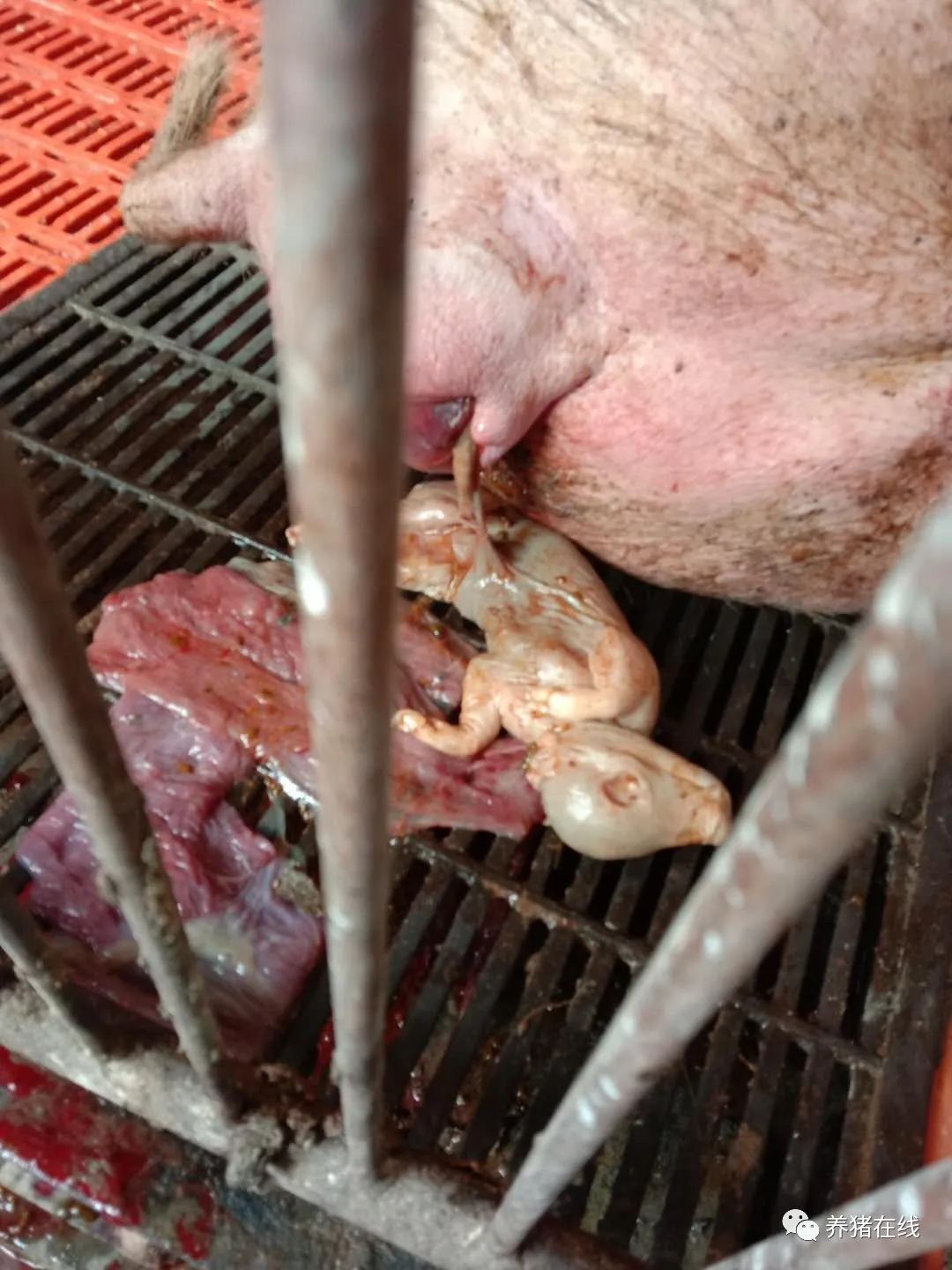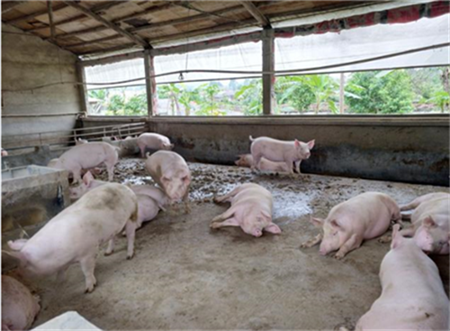Is there an outbreak of blue ear disease in the pig farm? Quickly compare whether there are these five omens.
Blue ear disease can be called the number one killer of pig farms, many pig farms talk about "blue" color change, and many people are actively exploring the prevention and control of the disease. But early warning is more important than control.
Experts believe that there are some omens before the outbreak of blue ear disease:
Within 14 days, the miscarriage or premature delivery of sows was more than 8%, and stillbirth accounted for 20% of the litter size.
The mortality rate of piglets within one week after birth is more than 25%.
Or a massive outbreak of Haemophilus parasuis.
The virus-carrying rate of pigs is over 30%.
The renewal rate of sows is over 40%, etc.
Farmers can use these indicators to evaluate the outbreak of blue ear disease in pig farms and take prevention and control measures in advance.

Foreboding: the miscarriage of sows is more than 8%.
Accuracy: ★★★★☆
Yang Hanchun, a professor at China Agricultural University, believes that the production performance of pig farms must have changed before the outbreak of blue-ear disease, especially the abortion rate of sows and the survival rate of piglets. If the pig farm has two of the following clinical indicators within 14 days, it can be determined as suspected cases of blue ears: 1, miscarriage or premature delivery of sows is more than 8%, stillbirth accounts for 20% of the number of litters, and the mortality rate of piglets within 1 week after birth is more than 25%.
It is reported that the Ministry of Agriculture has issued the main indicators for clinical diagnosis of highly pathogenic blue-ear disease:
The incidence of piglets can reach 100%, and the case fatality rate is more than 50%.
The abortion rate of pregnant sows is more than 30%; adult pigs also die of the disease.
The diagnosis must be confirmed by serological testing and virus isolation and identification. PRRSV specific IgG appeared 10-14 days after virus infection. Double sera (at onset and 2 weeks later) were collected to detect the change of antibody level. If the antibody level increased significantly without vaccination, it would indicate the occurrence of virus infection.
It is recommended to collect lung, lymph node, serum and other disease samples for virus isolation or virus detection (RT-PCR/ fluorescence quantitative RTPCR). Because the virus content in the serum is high, the virus-carrying time is long (usually up to 300 days), and the serum sample is easy to deal with, so it is the first choice for detection.
Foreboding two: sows with increased estrus and high body temperature
Accuracy: ★★★☆☆
According to Deng Xianbai, professor of South China Agricultural University,
Before the outbreak of blue ear disease in pig farms, the first was premature delivery of pregnant sows, followed by late abortion, stillbirth, mummies, weak babies, increased proportion of estrus and elevated body temperature.
The piglets had peripheral circulation disturbance, cyanosis and cyanosis of ear, tail, abdomen and vulva, and swelling of eyelids. The younger the age, the higher the mortality.
The respiratory symptoms of diseased pigs were obvious, such as sneezing and abdominal breathing.
If these symptoms are found in the pig herd, further autopsy should be performed on the diseased pig. The pathological changes of autopsy showed that the enlarged lymph nodes were ferruginous, especially in the mediastinal lymph nodes, and there were a lot of iron ions in the lymphatic sinus. Interstitial pneumonia, a little bleeding on the surface, slightly broadened interstitium, proliferation of lymphocytes in the bronchiolar and alveolar walls. The muscles are yellowing and edema.
Foreboding three: the virus-carrying rate of pigs is more than 30%.
Accuracy: ★★★★☆
"if the virus-carrying rate of pigs is more than 30%, then the possibility of an outbreak of blue ear disease in pig farms is very high." Fan Fuhao, director of the breeding Pig (Guangzhou) testing Center of the Ministry of Agriculture, told reporters that when the herd of infected pigs exceeds 30%, the environment cannot reach a balance through self-purification, the balance between antigens and antibodies is broken, and the disease can easily spread among the groups.
It is reported that the biggest workload of using this index to monitor blue-ear disease is to collect blood for testing the virus, of which the biggest headache is blood collection, which requires higher technical requirements for workers and greater stress in pigs. Some experts in the United States have pointed out through experiments that using saliva samples to detect blue ears and classical swine fever antigens and antibodies can achieve similar results with blood tests.
According to Fan Fuhao, the method of saliva collection is very simple, using gauze balls to collect saliva by making use of pigs' curiosity and hobby of chewing. The gauze is made into a gauze ball and fixed at the front of the wire, the pig will only actively chew the gauze ball, and saliva will enter the gauze ball through siphon. The saliva in the gauze ball is then extruded and released into the sample bag. Then transfer the saliva from the sample bag to the centrifuge tube. "it is much simpler than collecting blood, but this method has too many unstable factors and needs further research, and many pig farms abroad are trying it."
Omen 4: Haemophilus parasuis is rampant.
Accuracy: ★★★☆☆
"Haemophilus parasuis can be defined as an indicator of blue ear disease to some extent." Zhang Guihong, a professor at South China Agricultural University, said that if Haemophilus parasuis broke out on a large scale in a pig farm within a short period of time, it is necessary to find out whether it is primary or secondary, because pigs will be secondary to Haemophilus parasuis infection before the outbreak of blue ear disease.
According to Zhang Guihong's analysis, there are three main causes of blue-ear disease:
1. The immunity of blue ear vaccine is unscientific: one is not vaccinated, the second is unscientific vaccination, for example, only breeding pigs or piglets, or the same population is immunized with different strains of vaccine, and many different strains are used at the same time, the immune dose is insufficient, the immune interval is too long and so on.
2. Improper treatment after the occurrence of epidemic diarrhea or disease No. 5 in piglets, including failure to replenish and immunize blue ear, circus and classical swine fever vaccine in time (after the occurrence of these two diseases, affect the immune normal state of pigs, it is necessary to replenish and immunize the relevant vaccine in time after the epidemic is stable); failed to vaccinate blue ear vaccine in time according to the immunization procedure, resulting in leakage immunity; use foreign serum to control the epidemic, and also bring exotic blue ear virus.
3. Improper introduction: the health status of this farm and the introduced pig farm does not match; introduction in multiple breeding farms at the same time or successively; one-time mass introduction (the number of introduction exceeds 20% of the original number of sows), and so on.
Foreboding five: the renewal rate of sows is more than 40%
Accuracy: ★★☆☆☆
"if the rate of first-born sows is too high, blue ear disease is easy to break out." According to Cai Xuehui, a researcher at Harbin Veterinary Research Institute, first-born sows are usually unstable groups of antigens and antibodies, and blue ear virus is the most vulnerable. If the first-born sows and reserve sows in a farm add up to more than 40% of the herd, then you need to be highly vigilant against blue-ear disease and increase the number of blue-ear vaccines.
In clinical prevention and control, Yang Hanchun suggested that in view of the occurrence of blue-ear disease and positive unstable pig farms, use live attenuated vaccines, formulate reasonable immune procedures, control secondary bacterial infection in diseased pigs, and strengthen sanitary disinfection. At the same time, it is also necessary to treat sick and dead pigs, feces and pollutants innocuously.
The introduced negative reserve pigs were mixed and domesticated with sows before mating. The immunity of live vaccine against blue ear disease should be stopped after the production of pigs is stable. For blue ear disease positive stable pig farms, live attenuated vaccine should not be used, the feeding and management of sows should be strengthened, the introduction of positive breeding pigs should be prohibited, and negative reserve pigs should be mixed with sows and domesticated as early as possible before breeding. The blue ear disease negative pig farm had better not use the vaccine, and take good biosafety measures, the introduction should be strictly monitored and quarantined, the introduction of blue ear disease positive breeding pigs should be prohibited, and the pig farm should be monitored regularly to keep it negative.
- Prev

Analysis on the Prevention and Control measures of Pig High Fever in Nanjing (1)
Analysis on the Prevention and Control measures of Pig High Fever in Nanjing (1)
- Next

Clinical symptoms and treatment of the most acute porcine lung disease
Clinical symptoms and treatment of the most acute porcine lung disease
Related
- On the eggshell is a badge full of pride. British Poultry Egg Market and Consumer observation
- British study: 72% of Britons are willing to buy native eggs raised by insects
- Guidelines for friendly egg production revised the increase of space in chicken sheds can not be forced to change feathers and lay eggs.
- Risk of delay in customs clearance Australia suspends lobster exports to China
- Pig semen-the Vector of virus Transmission (4)
- Pig semen-the Vector of virus Transmission (3)
- Five common causes of difficult control of classical swine fever in clinic and their countermeasures
- Foot-and-mouth disease is the most effective way to prevent it!
- PED is the number one killer of piglets and has to be guarded against in autumn and winter.
- What is "yellow fat pig"? Have you ever heard the pig collector talk about "yellow fat pig"?

